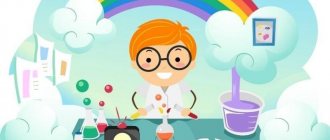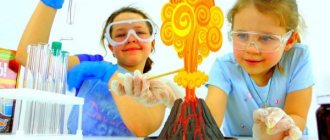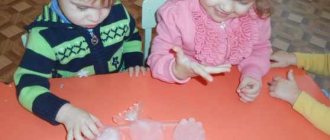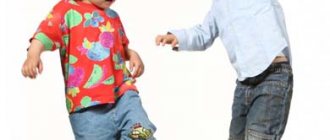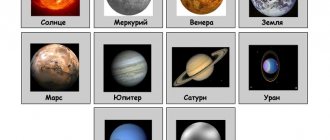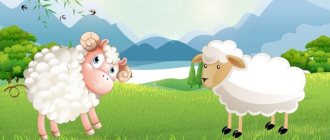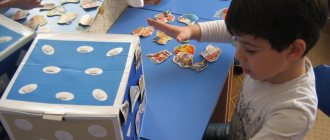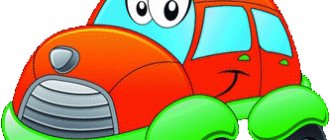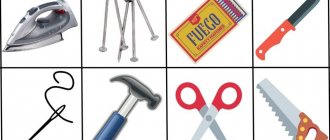Card index of experiences and experiments in ecology
Card index of experiences and experiments in ecology
(in the older group)
Card index
of experiences and experiments
for older preschoolers.
Experiment No. 1 “Magic devices”
Goal: familiarization with devices that help experimentation.
Objectives: introduce children to observation instruments: microscope, magnifying glass, telescope, telescope, binoculars;
give the opportunity, with the help of an adult, to find out the purpose of these devices, explain that they help determine the condition of natural objects, so that people know what measures need to be taken to save them;
develop children's interest in experimental activities; cultivate a sense of respect for nature.
Material: magnifying glasses, microscopes, various small objects, small seeds of fruits, vegetables, leaves of trees, plants, tree bark; binoculars, pictures of a spyglass, a telescope, pictures of a bird's beak, the eyes of a frog under a magnifying glass.
Move.
There are microscopes and magnifying glasses on the table. It is explained to the children that people have always wanted to look at some things closer - better than what can be seen with the eye. People learned to make glass thousands of years ago. But even the glass masters at first turned out to be cloudy. And they replaced glass... with stone. Yes, yes, a transparent stone - polished rock crystal. The result was a round piece of glass - a lens. And later they learned to make lenses from glass. First came the magnifying glass. Using a magnifying glass, scientists saw what they could not see before: the structure of a plant flower, legs, antennae and eyes of insects, and much more. Children are invited to look at the leaves through a magnifying glass. . After that, they are asked to look at the pictures and guess what the scientists looked at with a magnifying glass.
Bottom line. Optical instruments make it possible to study objects invisible to the eye.
Experiment No. 2 “What does a plant need to feed?”
Goal: to establish how the plant seeks light.
Objectives: to establish how a plant seeks light; without light, plant nutrition cannot be formed;
make it clear to children that plants need to be looked after and help nature develop;
clarify that to nourish plants, not only light is needed, but also moisture in the soil and air; cultivate a caring attitude towards plants.
Material. Indoor plants with hard leaves (ficus, sansevieria), adhesive plaster.
Move. An adult offers the children a riddle letter: what will happen if light does not fall on part of the sheet (part of the sheet will be lighter). Children's assumptions are tested by experience; part of the leaf is sealed with a plaster, the plant is placed near a light source for a week. After a week, the patch is removed.
Bottom line. Without light, plant nutrition cannot be produced.
Experiment No. 3 “What does the plant secrete?”
Goal: to establish that the plant produces oxygen.
Objectives: to enable children to understand the need for respiration for plants;
develop a sense of belonging to nature in relation to the plant world;
cultivate an ecological culture.
Material. A large glass container with an airtight lid, a cutting of a plant in water or a small pot with a plant, a splinter, matches.
Move. The adult invites the children to find out why it is so pleasant to breathe in the forest. Children assume that plants produce oxygen for human respiration. The assumption is proven by experience: a pot with a plant (or cutting) is placed inside a tall transparent container with an airtight lid. Place in a warm, bright place (if the plant provides oxygen, there should be more of it in the jar). After 1-2 days, the adult asks the children how to find out whether oxygen has accumulated in the jar (oxygen is burning). Observe the bright flash of flame from a splinter brought into the container immediately after removing the lid.
Bottom line. Plants release oxygen.
Experiment No. 4 “How to see the movement of water through the roots?”
Goal: to prove that the roots of the plant absorb water.
Objectives: to clarify the function of plant roots, to establish the relationship between structure and function;
enable children, with the help of an adult, to learn that plants, along with water, also absorb other substances found in the soil;
develop thinking, the ability to independently draw conclusions;
cultivate a caring attitude towards plants.
Material. Balsam cuttings with roots, water with food coloring.
Move. Children examine cuttings of geranium or balsam with roots, clarify the functions of the roots (they strengthen the plant in the soil, take moisture from it). What else can roots take from the ground? Children's assumptions are discussed. Consider dry food coloring - “food”, add it to water, stir. Find out what should happen if the roots can take up more than just water (the root should turn a different color). After a few days, the children sketch the results of the experiment in the form of an observation diary. They clarify what will happen to the plant if there are substances harmful to it in the ground (the plant will die, taking away harmful substances along with the water).
Bottom line. The root of the plant absorbs, along with water, other substances found in the soil.
Experiment No. 5 “Growing plants from carrot tops
»
Purpose: to consolidate what is necessary for growing plants.
Objectives: to give children the opportunity to see, using carrots as an example, that vegetation can also grow in sand;
convince children that the plant will grow if there is enough moisture and light;
cultivate interest in experimental activities.
Material:
sand, shallow container, carrot tops.
Move. Fill the container with sand. Water generously. Plant the tops of the carrots in the sand, cut side down. Put it in the light. Water throughout the week. Green stems and leaves will grow on the tops.
Bottom line. To grow plants you need light and moisture.
Experiment No. 6 “In the light and in the dark”
Target:
determine the environmental factors necessary for the growth and development of plants.
Objectives: to give children the opportunity, with the help of an adult, to find out by growing onions whether light is needed for plant life;
give children the opportunity to independently draw the conclusion that since the onion turned green in the light, it means that food has formed in it and, therefore, light is necessary for the growth and development of plants;
lay the beginnings of environmental thinking in children.
Material. Onion, a box made of durable cardboard, two containers with soil.
Move. An adult suggests finding out by growing onions whether light is needed for plant life. Cover part of the onion with a cap made of thick dark cardboard. Draw the result of the experiment after 7 - 10 days (the onion under the hood has become light). Remove the cap.
Bottom line. After 7–10 days, draw the result again (the onion turns green in the light, which means nutrition has formed in it).
Experiment No. 7 “Labyrinth”
Goal: to establish how the plant seeks light.
Objectives: to provide children with the opportunity to independently establish that if there is a lot of light, the plant is good, it turns green, if there is little light, the plant is bad;
consolidate the concept of “light”, knowledge of its meaning for all living things;
cultivate inquisitive consciousness and logical thinking.
Material. A cardboard box with a lid and partitions inside in the form of a labyrinth: in one corner there is a potato tuber, in the opposite there is a hole.
Move. Place the tuber in the box, close it, place it in a warm, but not hot place, with the hole facing the light source. Open the box after potato sprouts emerge from the hole. They examine, noting their directions, color (the sprouts are pale, white, curved in search of light in one direction). Leaving the box open, they continue to observe the change in color and direction of the sprouts for a week (the sprouts are now stretching in different directions, they have turned green).
Bottom line. A lot of light - the plant is good, it is green; little light - the plant is bad.
Experiment No. 8 “The sun gives us warmth and light”
Purpose: to give children an idea that the Sun is a source of heat and light.
Objectives: to introduce children to the concept of “light energy”, to show the degree of its absorption by various objects and materials;
give children the opportunity, with the help of an adult, to learn on a scientific basis that the Sun is a hot celestial body, the sun's rays heat the surface of the Earth, and from it the air heats up;
remember that warm air is lighter than cold air, so it rises;
develop in children the ability to reason and connect natural phenomena from an environmental point of view.
Material:
desk lamp; a set of objects made from different materials: paper, plastic, wood, metal; paper, scissors, thread, white and black scraps of fabric, light and dark stones, sand, needles.
Move. Children are asked to imagine that the light bulb is the Sun. Place your palm. (Warm, hot.) The palm became warm. Check whether different objects heat up from the light of a light bulb. What did you find? All objects heat up when light shines on them. The sun is a hot celestial body. Dark objects heat up more and absorb more sun - light energy.
Bottom line. The more heat rays a body absorbs, the higher its temperature becomes.
Experience No. 9
1. “The influence of sunlight on life on Earth
»,
2. “What colors does a sunbeam actually consist of?”
Goal: expanding children's knowledge about the Sun.
Objectives: to clarify children’s knowledge that on the sunny side the vegetation is lush, bright, green, and in the shade there is less vegetation;
bring children to understand that the sun's rays warm the Earth, warm soil is favorable for plant roots, mushrooms and other vegetation;
clarify how the children themselves feel in the sun;
introduce children to what colors a sunbeam actually consists of;
cultivate a love for nature.
1.Material: 2 stones.
Move. Place two pebbles: one in the sun, the other in the shade. Cover it with a thick wooden box to keep it dark. After some time, they check which pebble is warmer.
2.Material:
baking sheet, flat pocket mirror, sheet of white paper.
Move. The experiment should be carried out on a clear sunny day. Do not look directly at the sun or reflect the sun's rays into people's eyes. Fill a baking tray with water. Place it on a table near a window so that the light of the morning sun falls on it. Place the mirror inside the baking sheet, placing its top edge on the edge of the baking sheet and the bottom edge in the water at an angle so that it reflects the sunlight. Take a piece of paper with one hand and hold it in front of the mirror. With your other hand, move the mirror slightly. Adjust the position of the mirror and paper until a rainbow appears on it. Shake the mirror slightly. Sparkling multi-colored lights appear on the paper. The water splashes and changes the direction of the light, causing the colors to resemble lights.
Bottom line. The sun provides light and warmth necessary for life. The sunbeam is made up of colors that resemble lights. This is how it is reflected on the Earth.
Experiment No. 10 "Rostock"
Goal: to consolidate and generalize children’s knowledge about water, air, soil.
Objectives: to consolidate children’s knowledge about the need for water, air and soil for the growth and development of plants;
give children the opportunity to independently conduct an experiment from beginning to end, to feel their participation in experiments with natural objects; cultivate respect for the scientific profession.
Material. Tray of any shape, sand, clay, rotted leaves.
Move. Prepare the soil from sand, clay and rotted leaves; fill the tray. Then plant the seed of a quickly germinating plant (vegetable or flower) there. Pour water and place in a warm place. Take care of the sowing together with your children, and after a while you will have a sprout.
Bottom line.
Soil, water, air are necessary for the growth and development of plants.
Experiment No. 29 “Life cycle of flies
»
Goal: to introduce children to the life cycle of flies"
Objectives: to give children the opportunity to feel like real experimenters in the process of observing the life cycle of flies;
give children the opportunity, with the help of an adult, to learn about how Drosophila flies appear and how to avoid their appearance;
cultivate neatness in eating fruits, wash them thoroughly, do not leave cores or peels after eating, and observe the ecological cleanliness of fruits.
Material:
banana, liter jar, nylon stocking, pharmaceutical elastic band (ring).
Move. Peel the banana and put it in a jar. Leave the jar open for several days. Check the jar daily. When the fruit flies appear, cover the jar with a nylon stocking and tie it with an elastic band. Leave the flies in the jar for three days, and after this period, release them all. Close the jar again with the stocking. Monitor the jar for two weeks.
After a few days you will see larvae crawling along the bottom. Later, the larvae will develop into pupae, from which flies will eventually emerge.
Bottom line. Flies appear quickly if fruit is left open and warm, so fruit should be kept in the refrigerator.
Experiment No. 31 “How bird feathers are arranged”
Goal: to establish a connection between the structure and lifestyle of birds in the ecosystem.
Objectives: to enable children, with the help of an adult, to learn to reason why birds need flight and down feathers;
develop curiosity;
cultivate a love for birds.
Material: chicken feathers, goose feathers, magnifying glass, zipper lock, candle, hair, tweezers.
Move. Children examine the bird's flight feather, paying attention to the shaft and the fan attached to it. They find out why it falls slowly, spinning smoothly (the feather is light, since there is emptiness inside the rod). An adult suggests waving the feather, observing what happens to it when the bird flaps its wings (the feather springs elastically, without unraveling the hairs, maintaining its surface). Examine the fan through a strong magnifying glass (on the grooves of the feather there are protrusions and hooks that can be firmly and easily combined with each other, as if fastening the surface of the feather). Examining the down feather of a bird, they find out how it differs from the flight feather (the down feather is soft, the hairs are not interlocked, the shaft is thin, the feather is much smaller in size); children discuss why birds need such feathers (they serve to retain heat).
Bottom line. Birds need wings to fly.
Experiment No. 32 “Rainbow in the sky”
Goal: to introduce children to the property of light turning into a rainbow spectrum.
Objectives: to expand children’s knowledge about the natural phenomenon - the rainbow: why there is a rainbow in the sky, in what weather, what shape it is...
give children the opportunity, with the help of an adult, to learn about the scientist Isaac Newton, who discovered the color white;
give children the opportunity to make soap bubbles on their own and explain how they did it and what they resemble;
develop intelligence.
Materials: glass prism, Rainbow picture, bar soap, liquid soap, teaspoons, plastic glasses, sticks with a ring at the end, bowls, mirrors.
Move. Show the picture "Rainbow". The teacher invites the children to take small bowls and pour water into a little more than half the bowl. Place the mirror in the water at an angle. Catch a ray of sunlight with a mirror and direct it to the wall. Turn the mirror until all seven colors appear. Children perform an experiment. Game "Let's make soap bubbles." Children independently select the necessary materials. The teacher observes and provides individual assistance if necessary. Children play with bubbles.
Bottom line. Rainbow is the property of light to transform a ray of sun into multi-colored lights - a rainbow.
Topic: “Research activities with older children “Clean Planet””
International Pedagogical Olympiad
“Project and research activities in preschool educational institutions”
Municipal state preschool educational institution
kindergarten "Solnyshko" town. Mortka
Topic: “Research activities with older children
"Clean Planet"
Spent:
teacher
village Mortka, 2015
Conducting research activities with children of senior preschool age in preschool educational institutions using TRIZ techniques on the topic “Clean Planet”.
We have one copy of the Universe
and we cannot experiment on it.
.
In our age of modern civilization, the development of science and technology, the problem of garbage and unauthorized dumps is becoming more and more urgent
. Megacities and towns are “decorated” with solid waste (solid waste) landfills. Our village is no exception. The problem associated with the formation of unauthorized landfills on the territory of the village of Mortka and the disposal of solid waste has been brewing for a long time. We were also interested in the MDF plant, located almost on the territory of the village and the landfill owned by the plant. Therefore, the children of the older group and I decided to conduct a study on the topic: “Garbage: its impact on the ecology of the planet, and in particular our village.”
This material will highlight the problem of landfills in the forest, burning waste from an MDF plant, discharging production waste into the river and releasing harmful substances into the air. The guys and I will try to find ways to solve this complex and very important problem.
We set the goal of the study:
Show the importance of earth in the life of humans, animals and plants. Bring to an understanding of the negative consequences of land exploitation.
Based on the purpose of the study, we set the following tasks:
1. Form motives for children’s participation in upcoming activities.
2. Expand children’s knowledge about the interdependence of the natural world and human activities.
3. Stimulate interest in research activities, improve the ability to operate with existing knowledge, generalize, and draw conclusions.
4. Develop imagination, creativity, and communication skills during the implementation of the project.
5. To develop the ability to predict the consequences of one’s actions and the desire to live in an ecologically clean area.
We put forward a hypothesis:
If you introduce the TRIZ technique (modeling with little people) into the process of research activities, then children will be able to experience for themselves what the modeled object feels, it will be possible not only to explain to the child the phenomena surrounding him, but also to clearly show his changes.
To confirm the hypothesis and solve the problems, we used the following research methods
:
— analysis of statistical data (how much garbage is produced in the village, how much is taken to landfills and recycled, how long it takes for the garbage to be processed independently in nature);
— study and analysis of literature on the research topic;
- observation, experiment.
The study was conducted on the basis of the MKDOU kindergarten “Solnyshko” in the village of Mortka.
Organization of research activities.
1. Discussing the problem situation and drawing up an action plan
The teacher informs the children that June 5 is World Environment Day.
Questions for children: “Guys, what is the environment and why should it be protected? What danger threatens our planet and the people living on it? What kind of environment do you and I live in?”
Children come to the conclusion that the village in which we live is our environment. Next comes the discussion about whether we live well in the village and why? (The verbal game “Good - Bad” is played using a technique from TRIZ technology).
2. Practical activities
Cognitive and research activities
Any child by nature is an explorer, and experimentation is one of the types of children's activities that plays a huge role in the development of preschoolers.
We selected and studied the problem “What can we do to reduce waste?”
Children offer their solutions on how to make the air clean and fresh, how to get rid of garbage, how to help flora and fauna that are disappearing from environmental disasters, how to make life interesting and fun. You can involve the social partners of the preschool educational institution in this activity - these are parents, the library, the fire department, the forestry department, and the village administration.
The teacher, together with the children, conducts experiments and experiments in order to identify optimal conditions for human life.
Formulation of the problem -
What do you think will happen to the candy wrapper you threw in the forest?
This is where our friends come to the rescue - “little men”, with whom we can simulate this situation. Let's take the little men of “solid matter” - the earth, and add to them the black men (garbage). The people got mixed up.
Conclusion: It will take many years for the candy wrapper to completely dissolve in the ground, but we know that there is a lot of garbage thrown out in the forest and nature is no longer able to cope with it. It follows that garbage thrown out in the forest will remain there forever.
Guys, have you noticed that there are a lot of cars driving on the roads. They all pollute the air. Look what happens when a lot of cars spew exhaust fumes into the air. This is clean air. What kind of people will we depict?
D. - Gas men.
V. - Now let’s add exhaust gas men, there are many of them, they are black, you can’t breathe with them. They mix with the little men of clean air. What did the air become like?
Conclusion:
You cannot breathe this air, it is harmful not only to animals, but also to humans. Such air can cause many diseases: allergies, bronchitis, asthma. The same thing happens when our MDF plant releases harmful substances into the air, and when waste from the production of MDF boards is burned.
Let's conduct a study and look at whether smoke from burning landfills affects air pollution.
Fire and air research
progress of the research.
To make sure that the fire is polluting the air, carry out the following research. (It is carried out by an adult, strictly observing safety rules. In the warm season, it is better to conduct the study outside.) Taking all necessary precautions, light the candle. Can fire pollute the air? Hold a glass or porcelain (but not plastic!) container or other object made of material that will not melt or catch fire over a hot candle (at a distance of 1-2 cm). After some time, it will become noticeable that the object below has darkened and is covered with a layer of soot.
Conclusion.
When a fire burns, it releases pollutants into the air without us seeing it.
Connection to everyday life.
Many children have gas stoves in their apartments. All preschoolers saw gas burning. The experience with a candle showed that this pollutes the air (Naturally, when gas burns, other substances are released into the air than when a candle burns, but this is not so important for children yet). In order to breathe fresh air, you need to ventilate the kitchen.
Harmful substances are released into the air both from the flame of a fire and when garbage burns in landfills or fallen leaves in summer cottages.
We decided to check whether the landfills around the village affect our health.
The study “Where does the garbage go?”
Progress of the study.
Prepare a transparent container (sweet packaging, a small aquarium, half of a plastic bottle cut lengthwise will do), sponges, sand, a syringe, a pipette, a watering can with water, black gouache or other dark liquid diluted in water. Place a layer of sand on the bottom of the container and place sponges on top. (This way you recreate the soil model.) Lean one end of the container against a stand, such as a cube, so that it is tilted. Think of it as a hillside. It so happened that a harmful substance got onto this slope. For example, people threw away unsafe trash. Take a little dark liquid into a pipette and drop it onto your lips. Are dark spots on your lips clearly visible? Do they take up a lot of space on the hill? How many clean areas are left on it? So far the sponges (soil surface) are only slightly contaminated. But then it started to rain. (Have the child pour some water on the sponges.) What happens to the dark spots? Has the soil (sponges) become cleaner? Where can the specks go? Where does “rain” water accumulate? Invite one of the children to use a syringe to pump water out of the sand at the bottom of the container. Look carefully at the color of this water. Is it transparent? Why is it dark? Let's imagine that there is a well or lake at the bottom of the slope. What will the water be like after rain? Can I drink it? What if people plant a garden and grow plants in this area? Is it good that these plants will be watered with such dirty water?
Let's imagine that after some time it started raining over the hill again. Ask some guys to pour water from a watering can at the top of the slope, and others to pump out water with a syringe at the bottom. At a certain point, the water in the syringe will become clear. This means that the soil has cleared. Discuss with the children how long they watered the mound to clear the water.
Conclusion.
Harmful substances that people throw out in nature (including garbage), along with rain, fall into other places and pollute nature.
Connection to everyday life.
Discuss with your children the rules of behavior in nature, talk about why you should not leave garbage in recreation areas.
You cannot drink water from springs or wells that are located not far from landfills, or collect mushrooms, berries, or grow plants in such places.
We learned that the MDF plant discharges liquid waste from production into the Mortka River, so we decided to find out whether this harms the inhabitants of the river or not. From literary sources and the Internet, we see that many rivers, lakes, and seas are polluted. Dirty water flows into many of them from streets, factories and factories.
Using modeling, we will show how water pollution occurs.
Conclusion:
Unfortunately, people very often throw garbage into the water, drain the remaining gasoline, leave logs that then rot in the water, sink entire ships, without thinking about the consequences. In nature, everything is interconnected. Polluted river water flows into other rivers, seas, and oceans and pollutes them. Great harm is caused to aquatic life - fish, animals, insects, and plants. Often they simply die due to pollution.
We wondered how we could help nature, since it cannot cope with pollution on its own.
We conducted experiments on water purification with different filters. We came to the conclusion that it is possible to purify the water in the river using large special filters. The children remembered how the crocodile Gena in the cartoon covered the hole in the pipe from which dirty factory water flowed. And if this hole is closed with a filter that purifies the dirty water, the river will not be polluted.
A lot of garbage is thrown away, but we noticed that almost all household waste is recyclable, that is, it can be used as secondary raw materials. Therefore, waste can and should be sorted and delivered to various collection points.
Artistic and productive activity
Any old unnecessary thing can become new, beautiful, decorating the interior. We will prove this to you. See what unusual and beautiful things can be made from waste material (showing crafts made by children together with their parents).
While studying the problem of garbage and solid waste disposal with children, we came to the following conclusion
: From childhood (in the family, in kindergarten, at school), it is necessary to maintain order and cleanliness not only in your own apartment, but also in the village and in nature.
“Woke up in the morning - clean up your planet” (Antoine de Saint-Exupéry)
In the course of design and research activities, the children learned to invent, master new things, became open and able to express their own thoughts, they know how to make decisions and help each other, learned to formulate interests and realize their capabilities.
List of sources used
1. Voronkevich, welcome to ecology! Children's environmental projects. - SPb.: -PRESS", 20 p.
2. Ryzhova in kindergarten and at home: educational method. kit: method. allowance. — 2nd ed. M.: Linka-Press, 20 p.
3. Gyn on TRIZ in kindergarten: a manual for preschool teachers. institutions: 3rd ed. — Minsk: Information Computing Center of the Ministry of Finance, 20с.
Get text
